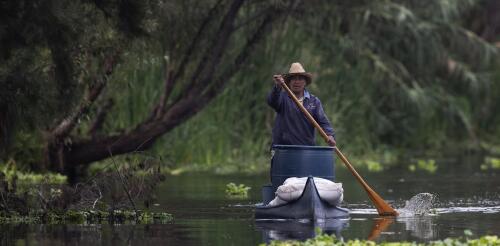Irrigation
In dozens of archaeological discoveries around the world, from the once-successful reservoirs and canals of Angkor Wat in Cambodia to the deserted Viking colonies of Greenland, new evidence paints pictures of civilizations struggling with unforeseen climate changes and the reality that their farming practices had become unsustainable. Among these discoveries are also success stories, where ancient farming practices helped civilizations survive the hard times. Zuni farmers in the southwestern United States made it through long stretches of extremely low rainfall between A.D. 1200 and 1400 by embracing small-scale, decentralized irrigation systems. Farmers in Ghana coped with severe droughts from 1450 to 1650 by planting indigenous African grains, like drought-tolerant pearl millet. Ancient practices like these are gaining new interest today. As countries face unprecedented heat waves, storms and melting glaciers, some farmers and international development organizations are rea...
If you stand at practically any point on Earth, there is water moving through the ground beneath your feet. Groundwater provides about half of the world’s population with drinking water and nearly half of all water used to irrigate crops. It sustains rivers, lakes and wetlands during droughts. Groundwater is a renewable resource, but it can take decades or even centuries for some aquifers to recover after they are depleted. Current understanding of this challenge is based mainly on where and how frequently people record measurements of water levels in wells. In a newly published study, our team of data scientists, water specialists and policy experts compiled the first global-scale dataset of these levels. We analyzed millions of groundwater level measurements in 170,000 wells located in over 40 countries and mapped how groundwater levels have changed over time. Our study has two main findings. First, we show that rapid groundwater depletion is widespread around the worl...
Arizona is one of the fastest-growing states in the U.S., with an economy that offers many opportunities for workers and businesses. But it faces a daunting challenge: a water crisis that could seriously constrain its economic growth and vitality. A recent report that projected a roughly 4% shortfall in groundwater supplies in the Phoenix area over the next 100 years prompted the state to curtail new approval of groundwater-dependent residential development in some of the region’s fast-growing suburbs. Moreover, negotiations continue over dwindling supplies from the Colorado River, which historically supplied more than a third of the state’s water. The Colorado River’s watershed extends across seven U.S. states and into Mexico. Use of river water is governed by a compact negotiated in 1922. Center for Colorado River Studies, CC BY-ND As a partial solution, the Arizona Water Infras...
When an explosion breached the Kakhovka Dam in Ukraine on June 6, 2023, much analysis focused on near-term impacts, including the flooding of the city of Kherson, threats to the Zaporizhzhia Nuclear Power Plant and consequences for Ukrainian military forces’ expected spring offensive against Russian troops. But the most severe long-term effects will fall on Southeast Ukraine’s farmers. Villages there were flooded. Roads, train tracks and irrigation canals were washed away. Crops in fields and orchards in the Kherson and Zaporizhzhia region were inundated, then left to shrivel after the water drained. The long-term ecological disaster will unfold over decades to come. Crimea, once a region known for its sunny beaches and rice fields, could dry up without irrigation. We are a U.S. political scientist with research expertise on the post-Soviet region and a Ukrainian economist who studies agriculture. While the long-term effects of the dam break are difficult to calcu...
A 23-year western drought has drastically shrunk the Colorado River, which provides water for drinking and irrigation for Wyoming, Colorado, Utah, New Mexico, Arizona, Nevada, California and two states in Mexico. Under a 1922 compact, these jurisdictions receive fixed allocations of water from the river – but now there’s not enough water to provide them. As states try to negotiate ways to share the decreasing flow, the U.S. Department of the Interior is considering cuts of up to 25% in allotments for California, Nevada and Arizona. The federal government can regulate these states’ water shares because they come mainly from Lake Mead, the largest U.S. reservoir, which was created when the Hoover Dam was built on the Colorado River near Las Vegas. These five articles from The Conversation’s archive explain what’s happening and what’s at stake in the Colorado River basin’s drought crisis. The Colorado River prov...




